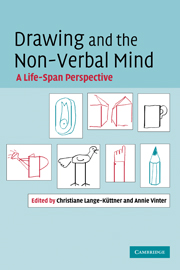Book contents
- Frontmatter
- Contents
- Contributors
- 1 Contemporary enquiries into a long-standing domain: Drawing research
- Part I Self, symbols and intention
- Part 2 Syntax, space systems and projection
- 7 The interaction of biomechanical and cognitive constraints in the production of children's drawing
- 8 Graphic syntax and representational development
- 9 Spatial structures in children's drawings: how do they develop?
- 10 Figures in and out of context: absent, simple, complex and halved spatial fields
- 11 Spatial and symbolic codes in the development of three-dimensional graphic representation
- 12 On contours seen and contours drawn
- Part III Aging, blindness and autism
- Index
- References
12 - On contours seen and contours drawn
Published online by Cambridge University Press: 22 September 2009
- Frontmatter
- Contents
- Contributors
- 1 Contemporary enquiries into a long-standing domain: Drawing research
- Part I Self, symbols and intention
- Part 2 Syntax, space systems and projection
- 7 The interaction of biomechanical and cognitive constraints in the production of children's drawing
- 8 Graphic syntax and representational development
- 9 Spatial structures in children's drawings: how do they develop?
- 10 Figures in and out of context: absent, simple, complex and halved spatial fields
- 11 Spatial and symbolic codes in the development of three-dimensional graphic representation
- 12 On contours seen and contours drawn
- Part III Aging, blindness and autism
- Index
- References
Summary
Deręgowski describes the ambiguities of object representations in pictorial space, in terms of dimensionality as well as view-specificity. On the basis of models of visual perception, he distinguishes between boundary contours, which result from the interaction of the solid and the background, and typical contours, which are inherent characteristics of the object itself. In several studies, he demonstrates empirically that typical contours can facilitate recognition if the object is in a fronto-parallel plane and thus this view is the most commonly depicted. However, several typical contours may compete for attention, in particular in children and illiterate adults. One solution was to depict several views of the object simultaneously in a co-planar fashion, as is demonstrated in several examples from ancient art and children. Another instance of the conflict between boundary and typical contour is the depiction of eyes (eye spots) in the fronto-parallel plane versus in profile, or, when in conflict, in a mixed version with eyes depicted en face but with the face contours in profile. Deręgowski finally concludes that whereas canonical contours establish themselves with experience, typical contours could be specified also for novel objects, and typical contour therefore seems the more satisfactory concept.
On contours seen
Each object within the observer's field of view furnishes a great variety of cues from which, combined and blended, his percept of the object arises.
- Type
- Chapter
- Information
- Drawing and the Non-Verbal MindA Life-Span Perspective, pp. 239 - 258Publisher: Cambridge University PressPrint publication year: 2008
References
- 1
- Cited by



